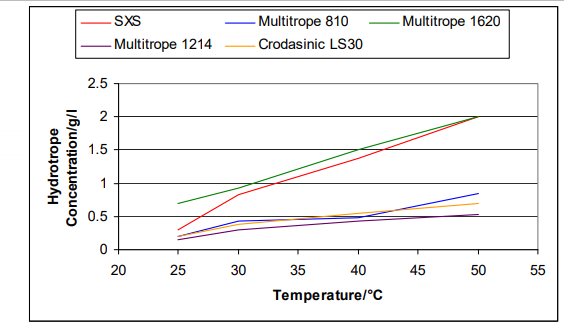Knowde Enhanced TDS
Identification & Functionality
- Chemical Family
- Chemical Name
- Cleaning Ingredients Functions
- CAS No.
- 68515-73-1
- EC No.
- 500-220-1
- Technologies
Features & Benefits
- Labeling Claims
- HII Features
- Product Highlights
- Excelllent stability and solubility in highly alkaline solutions.
- Good wetting properties.
- Effective hydrotroping.
- Compatible with a variety of surfactants (anionic, nonionic and amphoteric).
- Soluble in solutions containing high concentrations of electrolytes.
- Non-gelling over a range of aqueous solutions.
- Readily biodegradable.
- Bleach stable.
- Kitchen Cleaning
Multitrope 1620 is a sugar based, 100% natural surfactant. Producing a high foam lather and good detergency for removal of greasy stains, Multitro# 1620 is a versatile ingredient with hydrotrope functionality and stability in alkali systems. The lather and detergency is a winning combination for hand dishwash formulations where consumer perception of quick cleaning and high activity is paramount. In conjunction with degreasing solvents like Prifer 6813, Multitrope 1620 makes an effective oven cleaning formulation due to hydrotrope ability and stability in alkali formulations.
- Fabric Care – Wash
The Multitrope range from Croda are eco-friendly hydrotropes that bring cost efficacy and high performance to many formulations. In laundry liquids, Multitrope 810 is ideal for concentrated products as a replacement for Sodium Xylene Sulfonate. Working in high pH and high electrolyte systems, this easy to formulate product brings cost benefits through lower usage levels than other hydrotropes. For a fully natural alternative, Multitrope™ 1620 gives effective hydrotroping with anionic, cationic, non-ionic and amphoteric surfactant compatibility. This natural and green additive is more than just a hydrotrope providing dose reductions, wetting, foaming and performance as a detergent to bring all round cleaning benefits to a formulation.
Applications & Uses
- Markets
- Applications
- Home Care Applications
- I&I Cleaning Applications
- Applications
- Bottle wash liquid
- Metal cleaning
- Bathroom cleaners
- Paint strippers
- All purpose cleaners
- Dairy cleaning
- Cleaning in place
- Laundry detergents
Properties
- Physical Form
- Performance Properties
Synperonic
Cloud Point 250C Cloud Point 400C Surfactant (2%) Multitrope 1620 SxS Multitrope 1620 SxS LF/26 3.80 3.70 2.20 9.30 LF/27 1.79 3.30 3.73 8.85 LF/31 1.39 1.90 2.23 9.86 91/2.5 1.56 2.05 3.60 6.45 91/6 0.48 0.47 1.90 1.90 A3 3.60 3.75 3.20 9.90 Performance of Multitrope 1620 and SXS in a variety of surfactants
Multitrope 1620 is an effective hydrotrope for a number of ethoxylate and alkoxylate surfactants offering substantial dose reductions compared with a more conventional hydrotrope.
Regulatory & Compliance
- Certifications & Compliance
Technical Details & Test Data
- Solubility And Stability
Solubility in Electrolytes
Multitrope 1620 is soluble at 2.5% in the following solutions:
- 47% Sodium hydroxide
- 20% Tetra potassium pyro phosphate
- 25% Zinc sulfate
- 25% Sodium tri polyphosphate
- 40% Potassium hydroxide
- 40% Sodium silicate
Multitrope 1620 is soluble at concentrations up to 20% in 40% sodium hydroxide or potassium hydroxide.
Solubility In Oxidizing Agents
Formulations containing oxidizing agents are used in many types of cleaning operations. The stability and solubility of Multitrope 1620 in such solutions has been determined.
Multitrope 1620 is soluble at 2% in the following:
- Sodium hypochlorite (4% available chlorine) 20% hydrogen peroxide.
- Tests have shown that these solutions are stable when stored at ambient temperatures for several months.
Stability in Alkaline Solutions
Multitrope 1620 is resistant to attack by strong alkalis, hence has excellent long term stability in alkaline solutions. To demonstrate this, solutions containing 7% Multitrope 1620, 44% NaOH and 49% water were prepared, stored at 20°C and monitored periodically.
The solutions are stable for at least 12 months. After storage the solutions show:
- No evidence of phase separation or change in color
- No deterioration in foaming behavior
- No change in surface tension
- pH Comparison

Figure 1. Performance range for Croda hydrotropes
- Hydrotrope Comparison

Figure 2: Performance data for Croda hydrotropes in 2% alcohol ethyoxylate
Croda offers hydrotropes that are capable of solving solubility issues in a wide range of surfactant systems. These hydrotropes will regularly outperform more traditional hydrotropes such as sodium xylene sulphonate (SXS)
Safety & Health
- Environmental Properties
Multitrope 1620 shows ready biodegradability. Multitrope 1620 has undergone a comprehensive assessment in order to determine its likely environmental fate and effect.
In order to establish the environmental profile of the product, the ultimate biodegradability of Multitrope 1620 was determined using OECD Test guidelines revealing >60% BOD28/COD and greater than >70% Dissolved Organic Carbon removal from the aqueous phase.
The degree of ultimate biodegradation is consistent with the criteria used to differentiate readily biodegradable substances. Multitrope 1620 shows reduced environmental impact. The evaluation of acute toxicity to aquatic organisms for Multitrope 1620 has revealed a low order of effect. The 48 hour EC50 to the freshwater invertebrate Daphnia magna was found to be greater than 100 mg/liter and the assessment of toxicity to Pseudomonas putida, performed to characterize the potential for adverse effects on biological treatment, revealed a similar order of toxicity with an LC 50 greater than 560 mg/liter.
Biodegradability Ultimately Biodegradable Aquatic toxicity 48 hour EC50 Daphnia Magna min. 100mg/liter LC50 Pseudomonas Putida min. 560mg/liter - Aquatic Toxicity
Algae 37 mg/l Daphnia min. 100 mg/l Fish 100.81 mg/l
Packaging & Availability
- Country Availability
- Regional Availability





